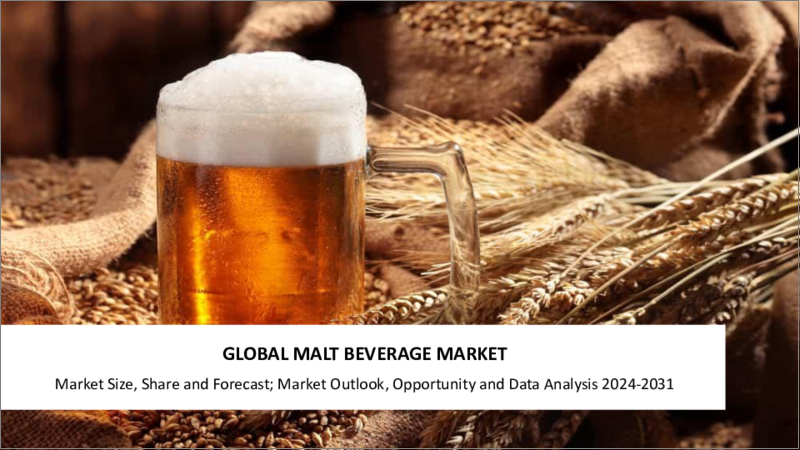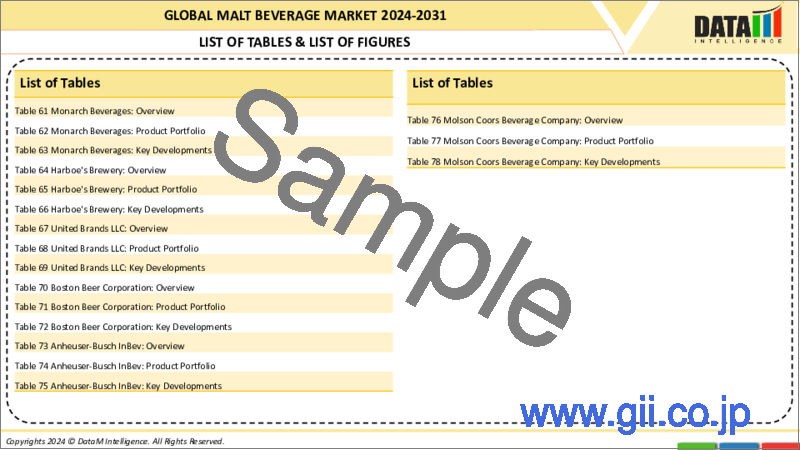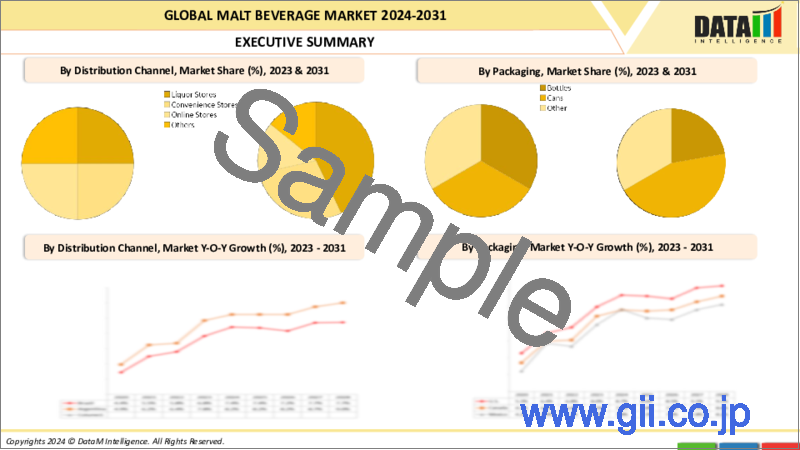|
|
市場調査レポート
商品コード
1304577
麦芽飲料の世界市場- 2023年~2030年Global Malt Beverage Market - 2023-2030 |
||||||
カスタマイズ可能
適宜更新あり
|
|||||||
| 麦芽飲料の世界市場- 2023年~2030年 |
|
出版日: 2023年07月07日
発行: DataM Intelligence
ページ情報: 英文 190 Pages
納期: 即日から翌営業日
|
- 全表示
- 概要
- 目次
市場概要
麦芽飲料の世界市場は、2022年に65億米ドルに達し、2030年には137億米ドルに達すると予測され、予測期間2023-2030年のCAGRは9.8%で成長すると予測されています。
麦芽飲料および麦芽ベースの飲料には、主要原料として麦芽エキスまたは麦芽穀物を利用する幅広い製品が含まれます。これには、麦芽ミルクセーキ、ホット飲料、スムージー、エナジードリンクなどが含まれます。これらの製品は、麦芽の独特の風味特性と栄養面での利点を活用して、消費者に多様で楽しい飲用体験を提供しています。
麦芽飲料の主な市場動向には、ノンアルコール飲料の増加、麦芽ベースの飲料の人気、原材料としての麦芽エキスの汎用性、風味の革新、醸造技術と発酵プロセス、天然素材と持続可能な原材料の重要性、栄養成分と機能性添加物の配合などがあります。これらの動向は、麦芽飲料市場における消費者の需要と嗜好の進化を反映しています。
市場力学
プレミアム化とクラフト文化の台頭が麦芽飲料産業を促進する見込み
プレミアム化には、消費者にワンランク上の特別な体験を提供する高品質の製品を提供することが含まれます。Global Data社のレポートによると、40%以上の消費者がプレミアムまたは高級アルコール飲料を少なくとも時折購入しています。消費者は、ユニークで洗練された飲用体験を提供するこれらの製品にプレミアムを支払うことを厭わないです。
クラフト文化は、飲料製造の背後にある職人技、技術、情熱を強調します。これは、クラフト生産者が製品にもたらす本物志向、細部へのこだわり、個性的なタッチを高く評価する消費者の共感を呼ぶ。クラフト麦芽飲料はこうした消費者感情に応えることが多く、小規模生産者の芸術性と献身を重視する消費者にアピールしています。
クラフト・麦芽飲料と特殊麦芽飲料の需要増加が麦芽飲料市場を促進する見込み
麦芽飲料市場は近年大きな成長を遂げています。クラフトビールメーカーは世界的に人気を博しており、消費者は独特の風味とスタイルを持つユニークな手作りビールへの関心を高めています。例えば、IWSRのレポートによると、プレミアムまたは「スーパープレミアム」アルコール飲料の市場シェアは、2024年までに13%に成長します。この成長は、クラフトビールや特殊麦芽飲料の市場環境が良好であることを示しています。
クラフト麦芽飲料や特殊麦芽飲料は、大量生産される代替品と比べて高価格帯になることが多いです。高品質の原料、伝統的な醸造技術、独特の風味に重点を置くことが、これらの製品のプレミアム化に寄与しています。このようなプレミアムなポジショニングは、生産者にとっては利益率の向上につながり、成長と収益性の好機を提供します。
麦芽飲料市場の成長を阻害する認識と固定観念の変化
麦芽飲料、特にビールをベースとする麦芽飲料は、時として過度の飲酒、中毒、無責任な行動に関連する否定的なステレオタイプと結び付けられることがあります。こうした固定観念は、麦芽飲料がもっぱら酩酊を目的として消費されるものであるという認識につながり、一部の消費者がこうした製品を探求したり受け入れたりすることを躊躇させる可能性があります。
多くの消費者は、麦芽飲料の多様性と可能性について限られた知識と理解しか持っていない可能性があります。麦芽飲料のさまざまな種類、フレーバー、潜在的なメリットに関するこのような認識の欠如は、消費者が馴染みのある主流の選択肢に固執する可能性があるため、麦芽飲料の成長を妨げる可能性があります。
COVID-19影響分析
COVID-19分析には、COVID前シナリオ、COVIDシナリオ、COVID後シナリオに加え、価格力学(COVID前シナリオと比較したパンデミック中およびパンデミック後の価格変動を含む)、需給スペクトラム(取引制限、封鎖、およびその後の問題による需給の変化)、政府の取り組み(政府機関による市場、セクター、業界を活性化させる取り組み)、メーカーの戦略的取り組み(COVID問題を緩和するためにメーカーが行ったことをここで取り上げる)が含まれます。
ロシア・ウクライナ戦争の影響
ウクライナは歴史的に、ロシアから欧州への天然ガス輸出の中継国でした。紛争はエネルギー安全保障への懸念とガス供給の途絶につながっています。ロシアとウクライナの間でガス価格や中継料に関する意見の相違が生じた結果、ガス紛争が数回発生し、ウクライナへの供給が途絶え、欧州のガス市場に波及する可能性が出てきました。紛争の発端となった2014年のロシアによるクリミア併合は、地域の安全保障と領土保全に関する国際規範に広範な影響を及ぼしています。国際社会はこの併合を大々的に非難したが、この問題は依然として争点となっています。
目次
第1章 調査手法と調査範囲
第2章 市場の定義と概要
第3章 エグゼクティブサマリー
第4章 市場力学
- 市場への影響要因
- 促進要因
- フレーバー飲料に対する顧客の嗜好の高まり
- 抑制要因
- 代替飲料カテゴリーとの激しい競合
- 機会
- 影響分析
- 促進要因
第5章 産業分析
- ポーターのファイブフォース分析
- サプライチェーン分析
- 価格分析
- 規制分析
第6章 COVID-19分析
第7章 フレーバー別
- フレーバー
- フレーバーなし
第8章 飲料タイプ別
- アルコール飲料
- ノンアルコール
第9章 流通チャネル別
- スーパーマーケット/ハイパーマーケット
- コンビニエンスストア
- オンラインストア
- その他
第10章 地域別
- 北米
- 米国
- カナダ
- メキシコ
- 欧州
- ドイツ
- 英国
- フランス
- イタリア
- スペイン
- その他欧州
- 南米
- ブラジル
- アルゼンチン
- その他南米
- アジア太平洋
- 中国
- インド
- 日本
- オーストラリア
- その他アジア太平洋地域
- 中東・アフリカ
第11章 競合情勢
- 競合シナリオ
- 市況/シェア分析
- M&A分析
第12章 企業プロファイル
- Nestle S.A.
- 会社概要
- 製品ポートフォリオと説明
- 財務概要
- 主な発展
- Danish Royal Unibrew Group
- Mondelez International
- PureMalt
- Van Pur S.A.
- Barbican
- RateBeer, LLC.
- Monarch Custom Beverages
- Harboe
- United Brands Company, Inc.
第13章 付録
Market Overview
The Global Malt Beverage Market reached US$ 6.5 billion in 2022 and is expected to reach US$ 13.7 billion by 2030 and is expected to grow with a CAGR of 9.8% during the forecast period 2023-2030.
Malted drinks and malt-based beverages encompass a wide range of products that utilize malt extracts or malted grains as key ingredients. These include malted milkshakes, hot beverages, smoothies, and energy drinks. These products leverage malt's unique flavor profile and nutritional benefits to offer consumers diverse and enjoyable drinking experiences.
The key market trends in malted beverages include the rise of non-alcoholic variants, the popularity of malt-based drinks, the versatility of malt extract as an ingredient, flavour innovation, brewing techniques and fermentation processes, the importance of natural and sustainable ingredients, and the inclusion of nutritional content and functional additives. These trends reflect the evolving consumer demands and preferences in the malted beverages market.
Market Dynamics
Rise in Premiumization and Craft Culture is Expected to Foster the Malt Beverage Industry
Premiumization involves offering high-quality products that provide consumers an elevated and exclusive experience. According to reports by Global Data, over 40% of consumers buy premium or luxury alcoholic drinks at least occasionally. Consumers are willing to pay a premium for these products that offer a unique and refined drinking experience.
Craft culture emphasizes the craftsmanship, skill, and passion behind the production of beverages. This resonates with consumers who appreciate the authenticity, attention to detail, and personalized touch that craft producers bring to their products. Craft malt beverages often cater to this consumer sentiment, appealing to those who value the artistry and dedication of small-scale producers.
Increasing Demand for Craft and Specialty Malt Beverages is Expected to Fuel the Malt Beverages Market
The malt beverages market has experienced significant growth in recent years. Craft breweries have gained popularity worldwide, and consumers are increasingly interested in unique, handcrafted beers with distinct flavors and styles. For instance, according to IWSR reports, the market share of premium or "super-premium" alcoholic drinks will grow to 13% by 2024. This growth indicates a favorable market environment for craft and specialty malt beverages.
Craft and specialty malt beverages often command a higher price point compared to mass-produced alternatives. The focus on quality ingredients, traditional brewing techniques, and unique flavor profiles contributes to the premiumization of these products. This premium positioning can lead to higher profit margins for producers, offering a favorable opportunity for growth and profitability.
Changing Perception and Stereotyping is Hampering the Malt Beverage Market Growth
Malt beverages, particularly those with a beer base, can sometimes be associated with negative stereotypes related to excessive drinking, addiction, and irresponsible behavior. These stereotypes can lead to a perception that malt beverages are solely consumed for intoxication purposes, which may deter some consumers from exploring or embracing these products.
Many consumers may have limited knowledge and understanding of the variety and potential of malt beverages. This lack of awareness about the different types, flavors, and potential benefits of malt beverages can hinder their growth as consumers may stick to familiar and mainstream options.
COVID-19 Impact Analysis
The COVID-19 Analysis includes Pre-COVID Scenario, COVID Scenario, and Post-COVID Scenario along with Pricing Dynamics (Including pricing change during and post-pandemic comparing it with pre-COVID scenarios), Demand-Supply Spectrum (Shift in demand and supply owing to trading restrictions, lockdown, and subsequent issues), Government Initiatives (Initiatives to revive market, sector or Industry by Government Bodies) and Manufacturers Strategic Initiatives (What manufacturers did to mitigate the COVID issues will be covered here).
Russia-Ukraine War Impact
Ukraine has historically been a transit country for Russian natural gas exports to Europe. The conflict led to concerns over energy security and disruptions in gas supplies. Disagreements between Russia and Ukraine on gas prices and transit fees have resulted in several gas disputes, leading to disruptions in supplies to Ukraine and potential spillover effects on European gas markets. The annexation of Crimea by Russia in 2014, which sparked the conflict, has had far-reaching implications for regional security and international norms on territorial integrity. The international community largely condemned the annexation, and it remains a contentious issue.
Segment Analysis
The Global Malt Beverage Market is segmented based on flavor, drink type, distribution channel, and region.
The Flavor Segment is Estimated to have Significant Growth During the Forecast Period.
Flavored malt beverages offer a wide range of taste options, catering to diverse consumer preferences. Flavors such as citrus, berry, tropical fruits, and spices add excitement and variety to the drinking experience. According to Statista, flavored malt beverages are alcoholic beverages that by regulation, must be made of 25 percent malt and 7.5 pounds of hops per 100 finished product barrels. Consumers often seek novel and unique flavors, driving the demand for flavored malt beverages.
The flavored segment is not limited to alcoholic malt beverages. Non-alcoholic flavored malt beverages, such as malted sodas or malt-based soft drinks, have become refreshing alternatives to traditional carbonated soft drinks. These non-alcoholic flavored options offer a unique flavor profile and nutritional benefits, appealing to health-conscious consumers.
Geographical Analysis
Asia Pacific is the Fastest Growing Market in The Malt Beverage Market
The Asia Pacific region is home to a large and rapidly growing population, including emerging economies such as China and India. Rising disposable incomes, urbanization, and changing lifestyles have contributed to increased consumer spending on food and beverages, including malt beverages. According to Statista, in the Alcoholic Drinks market, volume is expected to amount to 105,800.00 million liters by 2027. The market for Alcoholic Drinks market is expected to show a volume growth of 1.6% in 2024.
Malt beverages have a cultural significance in certain Asian countries, such as Japan and South Korea, where traditional malt-based drinks like "mugi-cha" and "boricha" are consumed. The presence of these traditional malt beverages, along with the growing popularity of Western-style malt beverages, contributes to the market's growth in the region.
Competitive Landscape
The major global players in the market include: Nestle S.A., Danish Royal Unibrew Group, Mondelez International, PureMalt, Van Pur S.A., Barbican, RateBeer, LLC., Monarch Custom Beverages, Harboe, and United Brands Company, Inc.
Why Purchase the Report?
- To visualize the Global Malt Beverage Market segmentation based on flavor, drink type, distribution channel, and region and understand key commercial assets and players.
- Identify commercial opportunities in the market by analyzing trends and co-development.
- Excel data sheet with numerous malt beverage market-level data points with all segments.
- The PDF report consists of a comprehensive market analysis after exhaustive qualitative interviews and an in-depth market study.
- Product mapping is available as Excel consists of key products of all the major market players.
The Global Malt Beverages Market Report Would Provide Approximately 61 Tables, 56 Figures And 190 pages.
Target Audience 2023
- Manufacturers/ Buyers
- Industry Investors/Investment Bankers
- Research Professionals
- Emerging Companies
Table of Contents
1. Methodology and Scope
- 1.1. Research Methodology
- 1.2. Research Objective and Scope of the Report
2. Market Definition and Overview
3. Executive Summary
- 3.1. Market Snippet, by Flavor
- 3.2. Market Snippet, by Drink Type
- 3.3. Market Snippet, by Distribution Channel
- 3.4. Market Snippet, by Region
4. Market Dynamics
- 4.1. Market Impacting Factors
- 4.1.1. Drivers
- 4.1.1.1. Rising Customer Inclination Towards Flavored Drinks and Beverages
- 4.1.2. Restraints
- 4.1.2.1. The Intense Competition from Alternative Beverage Categories
- 4.1.3. Opportunity
- 4.1.4. Impact Analysis
- 4.1.1. Drivers
5. Industry Analysis
- 5.1. Porter's Five Force Analysis
- 5.2. Supply Chain Analysis
- 5.3. Pricing Analysis
- 5.4. Regulatory Analysis
6. COVID-19 Analysis
- 6.1. Analysis of COVID-19 on the Market
- 6.1.1. Scenario Before COVID-19
- 6.1.2. Scenario During COVID-19
- 6.1.3. Scenario Post COVID-19
- 6.2. Pricing Dynamics Amid COVID-19
- 6.3. Demand-Supply Spectrum
- 6.4. Government Initiatives Related to the Market During Pandemic
- 6.5. Manufacturers Strategic Initiatives
- 6.6. Conclusion
7. By Flavor
- 7.1. Introduction
- 7.1.1. Market Size Analysis and Y-o-Y Growth Analysis (%), By Flavor
- 7.1.2. Market Attractiveness Index, By Flavor
- 7.2. Flavored*
- 7.2.1. Introduction
- 7.2.2. Market Size Analysis and Y-o-Y Growth Analysis (%)
- 7.3. Unflavored
8. By Drink Type
- 8.1. Introduction
- 8.1.1. Market Size Analysis and Y-o-Y Growth Analysis (%), By Drink Type
- 8.1.2. Market Attractiveness Index, By Drink Type
- 8.2. Alcoholic*
- 8.2.1. Introduction
- 8.2.2. Market Size Analysis and Y-o-Y Growth Analysis (%)
- 8.3. Non-Alcoholic
9. By Distribution Channel
- 9.1. Introduction
- 9.1.1. Market Size Analysis and Y-o-Y Growth Analysis (%), By Distribution Channel
- 9.1.2. Market Attractiveness Index, By Distribution Channel
- 9.2. Supermarkets/Hypermarkets*
- 9.2.1. Introduction
- 9.2.2. Market Size Analysis and Y-o-Y Growth Analysis (%)
- 9.3. Convenience Stores
- 9.4. Online Stores
- 9.5. Others
10. By Region
- 10.1. Introduction
- 10.1.1. Market Size Analysis and Y-o-Y Growth Analysis (%), By Region
- 10.1.2. Market Attractiveness Index, By Region
- 10.2. North America*
- 10.2.1. Introduction
- 10.2.2. Key Region-Specific Dynamics
- 10.2.3. Market Size Analysis and Y-o-Y Growth Analysis (%), By Flavor
- 10.2.4. Market Size Analysis and Y-o-Y Growth Analysis (%), By Drink Type
- 10.2.5. Market Size Analysis and Y-o-Y Growth Analysis (%), By Distribution Channel
- 10.2.6. Market Size Analysis and Y-o-Y Growth Analysis (%), By Country
- 10.2.6.1. The U.S.
- 10.2.6.2. Canada
- 10.2.6.3. Mexico
- 10.3. Europe
- 10.3.1. Introduction
- 10.3.2. Key Region-Specific Dynamics
- 10.3.3. Market Size Analysis and Y-o-Y Growth Analysis (%), By Flavor
- 10.3.4. Market Size Analysis and Y-o-Y Growth Analysis (%), By Drink Type
- 10.3.5. Market Size Analysis and Y-o-Y Growth Analysis (%), By Distribution Channel
- 10.3.6. Market Size Analysis and Y-o-Y Growth Analysis (%), By Country
- 10.3.6.1. Germany
- 10.3.6.2. The U.K.
- 10.3.6.3. France
- 10.3.6.4. Italy
- 10.3.6.5. Spain
- 10.3.6.6. Rest of Europe
- 10.4. South America
- 10.4.1. Introduction
- 10.4.2. Key Region-Specific Dynamics
- 10.4.3. Market Size Analysis and Y-o-Y Growth Analysis (%), By Flavor
- 10.4.4. Market Size Analysis and Y-o-Y Growth Analysis (%), By Drink Type
- 10.4.5. Market Size Analysis and Y-o-Y Growth Analysis (%), By Distribution Channel
- 10.4.6. Market Size Analysis and Y-o-Y Growth Analysis (%), By Country
- 10.4.6.1. Brazil
- 10.4.6.2. Argentina
- 10.4.6.3. Rest of South America
- 10.5. Asia-Pacific
- 10.5.1. Introduction
- 10.5.2. Key Region-Specific Dynamics
- 10.5.3. Market Size Analysis and Y-o-Y Growth Analysis (%), By Flavor
- 10.5.4. Market Size Analysis and Y-o-Y Growth Analysis (%), By Drink Type
- 10.5.5. Market Size Analysis and Y-o-Y Growth Analysis (%), By Distribution Channel
- 10.5.6. Market Size Analysis and Y-o-Y Growth Analysis (%), By Country
- 10.5.6.1. China
- 10.5.6.2. India
- 10.5.6.3. Japan
- 10.5.6.4. Australia
- 10.5.6.5. Rest of Asia-Pacific
- 10.6. Middle East and Africa
- 10.6.1. Introduction
- 10.6.2. Key Region-Specific Dynamics
- 10.6.3. Market Size Analysis and Y-o-Y Growth Analysis (%), By Flavor
- 10.6.4. Market Size Analysis and Y-o-Y Growth Analysis (%), By Drink Type
- 10.6.5. Market Size Analysis and Y-o-Y Growth Analysis (%), By Distribution Channel
11. Competitive Landscape
- 11.1. Competitive Scenario
- 11.2. Market Positioning/Share Analysis
- 11.3. Mergers and Acquisitions Analysis
12. Company Profiles
- 12.1. Nestle S.A.*
- 12.1.1. Company Overview
- 12.1.2. Product Portfolio and Description
- 12.1.3. Financial Overview
- 12.1.4. Key Developments
- 12.2. Danish Royal Unibrew Group
- 12.3. Mondelez International
- 12.4. PureMalt
- 12.5. Van Pur S.A.
- 12.6. Barbican
- 12.7. RateBeer, LLC.
- 12.8. Monarch Custom Beverages
- 12.9. Harboe
- 12.10. United Brands Company, Inc.
LIST NOT EXHAUSTIVE
13. Appendix
- 13.1. About Us and Services
- 13.2. Contact Us





